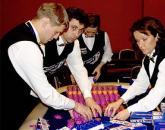Presentation on the topic: Electromotive force. Ohm's law for a complete circuit
slide 2
External forces Electromotive force Outer part of the circuit Inner part of the circuit Current source Concepts and quantities:
slide 3
Laws: Ohm for a closed circuit
slide 4
Short-circuit current Rules for electrical safety in various rooms Fuses Aspects of human life:
slide 5
Electromotive force. Ohm's law for a closed circuit. Current sources. In order to obtain a direct current in an electric circuit, some forces other than (Coulomb) forces must act on the charges electrostatic field. Such forces are called external forces. The characteristic of the action of external forces is the electromotive force (EMF), which is numerically equal to the work of external forces in moving a single positive (trial) charge along a closed circuit or, in other words, is determined by the work of external forces in moving a charge along a closed circuit, referred to the value of this charge, EMF is measured in volts. The section of the circuit on which there is an EMF is called an inhomogeneous section of the circuit. Inside the source, the charges move against the Coulomb forces under the action of external forces, and in the rest of the circuit they are set in motion by an electric field. Such sources can be galvanic cells, batteries, electric DC generators. The EMF of a current source is equal to the electrical voltage at its terminals in an open circuit. It follows from the law of conservation of energy that the work of external forces is equal to the amount of heat released in the circuit Q = I2 ∙ R0 ∙ ∆t where R0 = R + r is the total resistance of the circuit, and R is the resistance of the external circuit, r is the internal resistance of the source. Then ε ∙ I ∙ ∆t = I2 ∙ (R + r) ∆t
slide 6
From here we obtain Ohm's law for a complete circuit: The current strength in a complete circuit is equal to the electromotive force of the source divided by the sum of the resistances of the external and internal sections of the circuit. In the case when the resistance of the external circuit tends to zero, a short circuit current occurs in the circuit - the maximum possible current in a given source Short circuit current strength - the maximum current strength that can be obtained from given source with electromotive force and internal resistance r. For sources with low internal resistance, the short-circuit current can be very large and cause the destruction of the electrical circuit or source. For example, lead-acid batteries used in automobiles can have a short circuit current of several hundred amperes. Particularly dangerous are short circuits in lighting networks powered by substations (thousands of amperes). To avoid the destructive effect of such high currents, fuses or special circuit breakers are included in the circuit. In galvanic cells, the short circuit current is small and therefore it is not very dangerous for them.
Ohm's law for a closed circuit. Current sources. To obtain a direct current in an electric circuit, some forces must act on the charges, other than the (Coulomb) forces of the electrostatic field. Such forces are called external forces. The characteristic of the action of external forces is the electromotive force (EMF), which is numerically equal to the work of external forces in moving a single positive (trial) charge along a closed circuit or, in other words, is determined by the work of external forces in moving a charge along a closed circuit, referred to the value of this charge, EMF is measured in volts. The section of the circuit on which there is an EMF is called an inhomogeneous section of the circuit. Inside the source, the charges move against the Coulomb forces under the action of external forces, and in the rest of the circuit they are set in motion by an electric field. Such sources can be galvanic cells, batteries, electric DC generators. The EMF of a current source is equal to the electrical voltage at its terminals in an open circuit. It follows from the law of conservation of energy that the work of external forces is equal to the amount of heat released in the circuit Q = I2 ? R0? ?t where R0 = R + r is the total resistance of the circuit, and R is the resistance of the external circuit, r is the internal resistance of the source. Then? ? I? ?t = I2 ? (R + r) ?t.
slide 1
Description of the slide:
slide 2
Description of the slide:
slide 3
Description of the slide:
slide 4
Description of the slide:
slide 5
Description of the slide:
slide 6
Description of the slide:
Table "Types of current sources and the principle of their operation" Table "Types of current sources and the principle of their operation" Electrophore machine jar. Currently used mainly for demonstration experiments requiring controlled generation of large (up to tens of thousands of volts) voltages Galvanic cell Two different material immersed in a solution or other conductive medium. Due to irreversible chemical reactions taking place at the "solution - solid" boundary, electrons or charged ions are accumulated on the electrodes. In galvanic cells, the energy of chemical bonds accumulated during the synthesis of these substances is irreversibly converted into the energy of separated charges.
Slide 7
Description of the slide:
Slide 8 Description of the slide:
Description of the slide:
Source electric current and a metal conductor (resistor) form the simplest closed electrical circuit, in which the patterns of current flow were studied by G. Ohm. He showed that the current strength with a constant current source depends on the material of the conductor (r), its cross-sectional area (S) and length. An electric current source and a metal conductor (resistor) form the simplest closed electrical circuit in which the laws of current flow were studied by G. Ohm. He showed that the current strength with a constant current source depends on the material of the conductor (r), its cross-sectional area (S) and length. The section of the circuit containing the resistor is called external, and containing the current source - internal. Ohm's law for a closed (full) circuit allows you to calculate the current strength for circuits containing a current source with known EMF and known characteristics of the external conductor:
Slide 10
Description of the slide:

Ohm's law for a complete circuit
Physics teacher, secondary school No. 37 of the village of Staromyshastovskaya T.A. Pelipenko

Let's repeat the basic concepts
Electricity
directed motion of charged particles
physical quantity that indicates how much charge passes through cross section conductor per unit of time: 𝐼=𝑞/𝑡
Current strength
The unit of current strength is ampere
The area of the figure under the current strength graph is numerically equal to the charge (q=It)

Let's repeat the basic concepts
Ohm's law for a circuit section
Electrical resistance of metal conductors
Conditions for the existence of an electric current
The presence of free charges in matter
The presence of an external electric field(current source)

Current source is a device that converts some form of energy into electrical energy

Let's repeat the basic concepts
Exist different kinds current sources:
Mechanical current sources
Thermal current sources
Chemical current sources
Light current sources


The distribution of charges inside direct current sources occurs due to forces of non-electric origin (electromagnetic, chemical, mechanical forces, etc.), which are called outside forces
In any current source, work on the separation of positively and negatively charged particles , which accumulate at the poles of the source

Forces of non-electrical origin (mechanical, chemical, electromagnetic, etc.) cause the charges inside the current source to be redistributed between its poles

The ratio of the work of external forces to move charges inside the current source to the value of the displaced charge is called electromotive force (EMF) given current source
The unit of measurement of EMF in SI is volt
[ε]=1V

With an open circuit, the voltmeter shows EMF

Any DC source
has a certain internal
resistance
r is the internal resistance of the current source
[r] = 1 ohm

Ohm's law for a complete circuit
I - current strength in the circuit
R - resistance of the external section of the circuit
r is the internal resistance of the current source
– EMF current source

A short closure

Transforming Ohm's law
for a complete circuit,
we get the following expression
Potential difference inside
current source
ε = IR + Ir
External voltage
chain section

Exercise 1
The battery emf is 2 V. With a current in the circuit of 2 A, the voltage at the battery terminals is 1.8 V. Find the internal resistance of the battery and the resistance of the external circuit

Let's check the solution of the problem
Answer: R \u003d 0.9 Ohm; r = 0.1 ohm.
Answer: R \u003d 0.9 Ohm; r = 0.1 ohm.
ε=U+Ir, r =
r = = 0.1 ohm


Let's check the solution of the problem
Given:
R = 20 ohm
Solution
Ɛ = 5 V
Since the current sources are connected in series,
Answer: U = 4 V.
r = 2.5 ohm
Ɛ = U + 2 Ir
U = Ɛ - 2 Ir
U \u003d 5 V - 2 0.2 A 2.5 ohm = 4V

§ 107, § 108, ex. 19 (tasks 6, 7, 8)

Thank you
Electromotive force. Ohm's law for a complete circuit.
Lesson 10 class


Let us connect two metal balls with opposite charges with a conductor.
Under the influence of the electric field of these charges, an electric current arises in the conductor.
But this current will be very short-lived.
The charges are quickly neutralized, the potentials of the balls become the same, and the electric field disappears.

Third party forces
In order for the current to be constant, it is necessary to maintain a constant voltage between the balls.
This requires a device (current source) that would move the charges from one ball to another in the direction opposite to the direction of the forces acting on these charges from the electric field of the balls.
In such a device, in addition to electric forces, the charges must be affected by forces of non-electric origin.
The electric field of charged particles alone (the Coulomb field) is not capable of maintaining a constant current in the circuit.

External forces set in motion charged particles inside all current sources: in generators at power plants,
in galvanic cells,
batteries, etc.
Alternator, Russia
Accumulator, Tyumen
Galvanic cells, USSR

When the circuit is closed, an electric field is created in all conductors of the circuit.
Inside the current source, the charges move under the action of external forces against the Coulomb forces (electrons from a positively charged electrode to a negative one), and in the rest of the circuit they are set in motion by an electric field.

The nature of external forces
Current sources
third party force
power plant generator
Force exerted by a magnetic field on electrons in a moving conductor
Galvanic cell
(Volta element)
Chemical forces that dissolve zinc in sulfuric acid solution

Electromotive force
The action of external forces is characterized by an important physical quantity called electromotive force (abbreviated as EMF).
The electromotive force in a closed loop is the ratio of the work of external forces when the charge moves along the loop to the charge:
EMF is expressed in volts: [Ɛ] = J/C = IN

Consider the simplest complete (closed) circuit, consisting of a current source and a resistor with resistance R.
Ɛ – EMF of the current source,
r is the internal resistance of the current source,
R is the external resistance of the circuit,
R + r is the total resistance of the circuit.
Ohm's law for a closed circuit relates the current in the circuit, EMF and impedance R + r chains.
Let's establish this connection theoretically using the laws of conservation of energy and Joule-Lenz.

Let an electric charge pass through the cross section of the conductor in time.
When this work is done, an amount of heat is released on the inner and outer sections of the circuit, equal, according to the Joule-Lenz law:
Q = I²∙R∙∆t + I²∙r∙∆t
The current strength in a complete circuit is equal to the ratio of the EMF of the circuit to its impedance .
 0. For this circuit: Ɛ = Ɛ₁ - Ɛ₂ + Ɛ₃ and Rp = R + r₁ + r₂ + r₃ If Ɛ 0, then I 0 → the direction of the current coincides with the direction of bypassing the circuit. "width="640"
0. For this circuit: Ɛ = Ɛ₁ - Ɛ₂ + Ɛ₃ and Rp = R + r₁ + r₂ + r₃ If Ɛ 0, then I 0 → the direction of the current coincides with the direction of bypassing the circuit. "width="640" If the circuit contains several series-connected elements with EMF Ɛ₁, Ɛ₂, Ɛ₃, etc., then the total EMF of the circuit is equal to the algebraic sum of the EMF of individual elements.
To determine the sign of the EMF, we choose the positive direction of bypassing the circuit.
If, when bypassing the circuit, they move from the “-” pole to the “+”, then the EMF Ɛ 0.
For this circuit: Ɛ = Ɛ₁ - Ɛ₂ + Ɛ₃ And Rп = R + r₁ + r₂ + r₃
If Ɛ 0 , That I 0 →
the current direction is the same as the loop bypass direction.

Problem solving
- What is the voltage at the terminals of a galvanic cell with an emf equal to Ε if the circuit is open?
- What is the current strength during a short circuit of a battery with an EMF Ε = 12 V and an internal resistance r = 0.01 Ohm?
- The flashlight battery is connected to a variable resistance resistor. With a resistor of 1.65 ohms, the voltage across it is 3.30 V, and with a resistance of 3.50 ohms, the voltage is 3.50 V. Determine the EMF and internal resistance of the battery.
- Current sources with an EMF of 4.50 V and 1.50 V and internal resistances of 1.50 ohms and 0.50 ohms, connected as shown in figure (15.13), feed the lamp from a flashlight. What power does the lamp consume if it is known that the resistance of its filament when heated is 23 ohms?

Bibliography:
- G.Ya. Myakishev, B.B. Bukhovtsev "Physics" Grade 10, "ENLIGHTENMENT", Moscow 2001
Popular
- Saratov plant of heavy gear cutting machines, sztzs
- Business plan for the provision of services for sharpening metal-cutting tools Open a workshop for sharpening tools
- Own business - tool sharpening studio Open a tool sharpening workshop
- Equipment for the production of cuttings
- Carpentry workshop business plan Carpentry workshop organization
- What is remote work at home What is remote work on the Internet
- Business idea: auto parts store
- How to organize a business for breeding fish in artificial reservoirs
- How to start your business - a step-by-step plan from scratch
- What kind of business can be opened in the village from scratch




